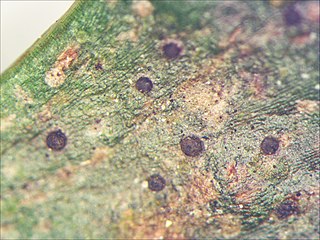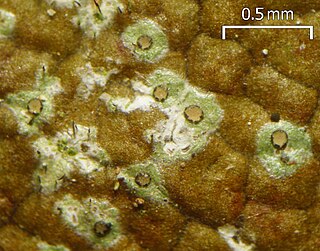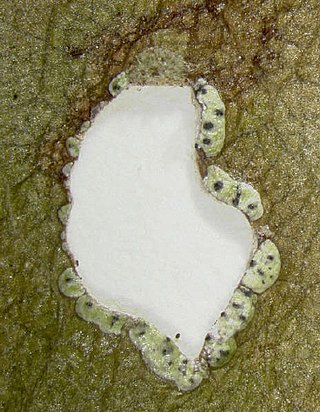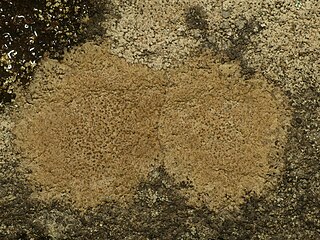
Capnodiales is a diverse order of Dothideomycetes, initially based on the family Capnodiaceae, also known as sooty mold fungi. Sooty molds grow as epiphytes, forming masses of black cells on plant leaves and are often associated with the honeydew secreted by insects feeding on plant sap. This diverse order has been expanded by the addition of several families formerly thought unrelated and now also includes saprobes, endophytes, plant pathogens, lichens and rock-inhabiting fungi. The new additions include the genus Mycosphaerella containing the causal agents of several economically important crop and tree diseases. A small number of these fungi are also able to parasitise humans and animals, including species able to colonise human hair shafts.

The Gomphillaceae are a family of lichen-forming fungi in the order Graphidales. Species in this family are found mostly in tropical regions.
Anomomorpha is a genus of lichens in the family Graphidaceae. The genus, described in 1891, has a pantropical distribution.
Sulcopyrenula is a genus of lichen-forming fungi in the family Pyrenulaceae. It contains five species. The genus was circumscribed by Hiroshi Harada in 1999, with Sulcopyrenula staurospora assigned as the type species. It is distinguished from other genera in the Pyrenulaceae by its longitudinally grooved ascospores.

Tapellaria is a genus of leaf-dwelling lichens in the family Pilocarpaceae. The genus was circumscribed by lichenologist Johannes Müller Argoviensis in 1890, with Tapellaria herpetospora assigned as the type species.

Mazosia is a genus of lichen-forming fungi in the family Roccellaceae. The genus was circumscribed by Italian lichenologist Abramo Bartolommeo Massalongo in 1854.

Catapyrenium is a genus of lichens in the family Verrucariaceae. The genus was circumscribed by German botanist Julius von Flotow in 1850.
Merismatium is a genus of lichenicolous (lichen-dwelling) fungi of uncertain familial placement in the order Verrucariales. The genus was circumscribed in 1898 by Friedrich Wilhelm Zopf.
Telogalla is a genus of lichenicolous fungi in the family Verrucariaceae. It has two species. The genus was circumscribed by Nikolaus Hoffmann and Josef Hafellner.

Asterothyrium is a genus of leaf-dwelling lichens in the family Gomphillaceae.
Calenia is a genus of lichen-forming fungi within the family Gomphillaceae.
Echinoplaca is a genus of lichens in the family Gomphillaceae.
Psorotheciopsis is a genus of lichenized fungi in the family Gomphillaceae. It contains three species.

Tricharia is a genus of lichens in the family Gomphillaceae. It has an estimated 30 species.
Trichosphaerella is a genus of lichenicolous fungi in the family Niessliaceae.

Strigula is a genus of lichen-forming fungi in the family Strigulaceae. The genus was circumscribed in 1823 by English mycologist Elias Magnus Fries.

Arthrorhaphis is a genus of lichen-forming fungi in the monotypic family Arthrorhaphidaceae. It has 13 species. The genus was circumscribed by Theodor Magnus Fries in 1860. The family was proposed by lichenologists Josef Poelt and Josef Hafellner in 1976. Species in this family have a widespread distribution in temperate and montane habitats. They grow symbiotically with green algae, or parasitically on other lichens. The family Arthrorhaphidaceae has an uncertain taxonomic placement in the class Lecanoromycetes; that is, it is incertae sedis with respect to ordinal placement.
Crypthonia is a genus of lichen-forming fungi in the family Arthoniaceae. It has 16 species. The genus was circumscribed in 2010 by Andreas Frisch and Göran Thor, with Crypthonia polillensis assigned as the type species.
Inoderma is a genus of lichen-forming fungi in the family Arthoniaceae. It was resurrected for use in 2015 for a small group of species with the following features: elevated, white pruinose pycnidia, immersed to adnate white pruinose apothecia, and a weakly gelatinized hymenium. Inoderma byssaceum was assigned as the type species for the genus.

Ionaspis is a genus of lichen-forming fungi in the family Hymeneliaceae. It contains six species of saxicolous (rock-dwelling), crustose lichens. The genus was originally circumscribed in 1871 by Theodor Magnus Fries. He segregated the genus from Aspicilia based on the presence of Trentepohlia rather than Trebouxia as the photobiont partner.









